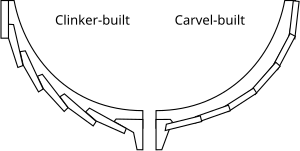
Back Skandinavski klinker čamci BS Buc tinglat Catalan Klinkerová obšívka Czech Klinkbygning Danish Nordic clinker boat traditions DAG Beplankung German Casco trincado Spanish Laidoitus Finnish Bordages à clin French Clinker (boat building) GPE
This article has multiple issues. Please help improve it or discuss these issues on the talk page. (Learn how and when to remove these messages)
|
Clinker-built, also known as lapstrake-built,[1][2] is a method of boat building in which the edges of longitudinal (lengthwise-running) hull planks overlap each other. Where necessary in larger craft, shorter hull planks can be joined end to end, creating a longer hull plank (strake).[not verified in body]

The technique originated in Nordic shipbuilding, and was employed by the Anglo-Saxons, Frisians, and Scandinavians.[when?][not verified in body] It was also used in cogs, the other major ship construction type found in Northern Europe in the latter part of the medieval period. Carvel construction—where longitudinal hull planks abut edge to edge (instead of lapping)—supplanted clinker construction in large vessels as the demand for capacity surpassed the limits of clinker construction, such as in larger medieval transport ships (hulks).[3]
UNESCO named the Nordic clinker boat tradition to its List of Intangible Cultural Heritage on December 14, 2021, in the first approval of a joint Nordic application.[4]
- ^ Cite error: The named reference
Webb2008was invoked but never defined (see the help page). - ^ Cite error: The named reference
Danenberg2020was invoked but never defined (see the help page). - ^ Lewis, Marcus & TMS Staff (2013-05-08). "Clinker and Carvel—Different Types of Planking". Boat-Building.org. Falmouth, Cornwall, England (and other): Traditional Maritime Skills (TMS). Archived from the original on 2013-05-08. Retrieved 2015-02-10.
- ^ Cite error: The named reference
UNESCO_2021was invoked but never defined (see the help page).